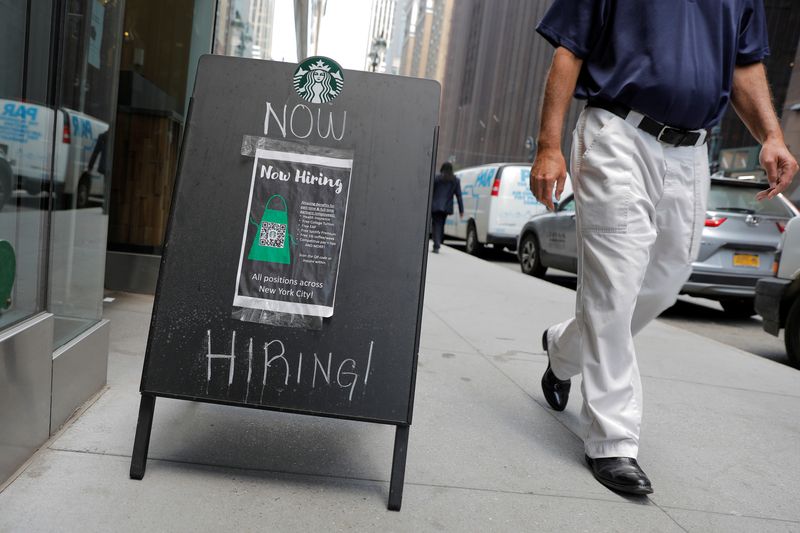Economy
Top 5 things to watch in markets in the week ahead

© Reuters
Investing.com — Friday’s nonfarm payrolls report and Wednesday’s minutes of the Federal Reserve’s June meeting will be the highlights of a holiday-shortened week. The stock markets go into the second half with a tailwind after strong gains in the first six months of the year. The Reserve Bank of Australia is set to make its latest rate decision while PMI data from China is likely to underscore the need for more stimulus measures
1. Nonfarm payrolls
Friday’s will be the main event, with economists expecting the economy to have added 200,000 jobs in June.
In May, the economy added a far larger than forecast 339,000 jobs, although an uptick in the to a seven-month high of 3.7% indicated that labor market conditions were easing.
Signs of continued strength in the labor market could underline a view that has helped boost markets this year: that the U.S. economy can avoid a severe recession despite the Fed’s aggressive tightening.
“The labor market is probably going to end up proving to be the big catalyst for what may happen market-wise and also monetary policy-wise,” Omar Aguilar, chief executive officer and chief investment officer of Schwab Asset Management told Reuters.
Ahead of Friday’s jobs report, markets will get updates on other areas of the labor market with data on private sector hiring from , and weekly unemployment claims.
2. Fed minutes
The Fed on Wednesday is to publish the minutes of its June 13-14 meeting when it held rates steady after 10 straight rate hikes, but indicated that two more increases are coming this year, including one widely expected in July.
On Friday a gauge of inflation that is closely followed by the U.S. central bank indicated that price pressures are cooling, fueling hopes the Fed could be near the end of its rate-hiking cycle.
The minutes should give investors more insight into the debate over what Fed Chair Jerome Powell has said is an increasingly even balance of risks between doing too little and going too far on policy tightening.
In comments last Thursday Powell reiterated that “a strong majority” of Fed policymakers expect they will need to raise interest rates at least twice more by year’s end.
3. Second half gets underway
The U.S. stock market has rallied in the first half of 2023, powering higher despite a crisis in the banking sector and fears over the prospect of a recession.
The has risen 15.9% since the start of the year and the tech-heavy has gained 31.7%, for its biggest first-half increase in 40 years.
“We have had a pretty resilient market in the first half of this year,” Mona Mahajan, senior investment strategist at Edward Jones told Reuters. “The market needs one big question answered, and that is what does the economy look like in the back half of the year.”
Investors are hoping that the strong gains in the first half of the year will give a tailwind to markets going into the second half of the year, but this month will bring several market-moving events – Friday’s jobs report, followed by the start of second-quarter earnings season along with a key inflation report next week ahead of the Fed’s next policy decision on July 26.
4. RBA decision
The Reserve Bank of Australia holds its July policy on Tuesday and markets are unsure of whether it might further raise the 4.1% cash rate or pause to see how past tightening is working.
The RBA has hiked interest rates by a huge 400 basis points in the past year in an attempt to cool demand and curb sky-high inflation.
Resilient data last Thursday suggested some cushion for another rate rise, a day after data showing that inflation slowed sharply in May to its lowest in 13 years saw an aggressive paring of tightening bets.
Prior to that, a blockbuster jobs report mid-month had seen hike bets rise, after getting wound down following surprisingly dovish minutes of the June meeting, showing the decision to raise rates was “finely balanced”.
5. China factory PMI
China is to release the on Monday which will give an update on the strength of the manufacturing sector as the post-COVID economic recovery in the world’s second-largest economy falters.
The data is likely to underscore the need for more stimulus measures amid weak demand both at home and abroad and prop up a weakening currency.
The has lost nearly 5% to the dollar this year, becoming one of the worst-performing Asian currencies.
Widening bond yield differentials between the U.S. and China, fueled by growing monetary policy divergence have pressured the yuan.
–Reuters contributed to this report
Economy
Russian central bank says it needs months to make sure CPI falling before rate cuts -RBC


© Reuters. Russian Central Bank Governor Elvira Nabiullina attends a news conference in Moscow, Russia June 14, 2019. REUTERS/Shamil Zhumatov/File Photo
MOSCOW (Reuters) – Russia’s central bank will need two to three months to make sure that inflation is steadily declining before taking any decision on interest rate cuts, the bank’s governor Elvira Nabiullina told RBC media on Sunday.
The central bank raised its key interest rate by 100 basis points to 16% earlier in December, hiking for the fifth consecutive meeting in response to stubborn inflation, and suggested that its tightening cycle was nearly over.
Nabiullina said it was not yet clear when exactly the regulator would start cutting rates, however.
“We really need to make sure that inflation is steadily decreasing, that these are not one-off factors that can affect the rate of price growth in a particular month,” she said.
Nabiullina said the bank was taking into account a wide range of indicators but primarily those that “characterize the stability of inflation”.
“This will take two or three months or more – it depends on how much the wide range of indicators that characterize sustainable inflation declines,” she said.
The bank will next convene to set its benchmark rate on Feb. 16.
The governor also said the bank should have started monetary policy tightening earlier than in July, when it embarked on the rate-hiking cycle.
Economy
China identifies second set of projects in $140 billion spending plan


© Reuters. FILE PHOTO: Workers walk past an under-construction area with completed office towers in the background, in Shenzhen’s Qianhai new district, Guangdong province, China August 25, 2023. REUTERS/David Kirton/File Photo
SHANGHAI (Reuters) – China’s top planning body said on Saturday it had identified a second batch of public investment projects, including flood control and disaster relief programmes, under a bond issuance and investment plan announced in October to boost the economy.
With the latest tranche, China has now earmarked more than 800 billion yuan of its 1 trillion yuan ($140 billion) in additional government bond issuance in the fourth quarter, as it focuses on fiscal steps to shore up the flagging economy.
The National Development and Reform Commission (NDRC) said in a statement on Saturday it had identified 9,600 projects with planned investment of more than 560 billion yuan.
China’s economy, the world’s second largest, is struggling to regain its footing post-COVID-19 as policymakers grapple with tepid consumer demand, weak exports, falling foreign investment and a deepening real estate crisis.
The 1 trillion yuan in additional bond issuance will widen China’s 2023 budget deficit ratio to around 3.8 percent from 3 percent, the state-run Xinhua news agency has said.
“Construction of the projects will improve China’s flood control system, emergency response mechanism and disaster relief capabilities, and better protect people’s lives and property, so it is very significant,” the NDRC said.
The agency said it will coordinate with other government bodies to make sure that funds are allocated speedily for investment and that high standards of quality are maintained in project construction.
($1 = 7.1315 renminbi)
Economy
Russian central bank says it needs months to make sure CPI falling before rate cuts -RBC


© Reuters. Russian Central Bank Governor Elvira Nabiullina attends a news conference in Moscow, Russia June 14, 2019. REUTERS/Shamil Zhumatov/File Photo
MOSCOW (Reuters) – Russia’s central bank will need two to three months to make sure that inflation is steadily declining before taking any decision on interest rate cuts, the bank’s governor Elvira Nabiullina told RBC media on Sunday.
The central bank raised its key interest rate by 100 basis points to 16% earlier in December, hiking for the fifth consecutive meeting in response to stubborn inflation, and suggested that its tightening cycle was nearly over.
Nabiullina said it was not yet clear when exactly the regulator would start cutting rates, however.
“We really need to make sure that inflation is steadily decreasing, that these are not one-off factors that can affect the rate of price growth in a particular month,” she said.
Nabiullina said the bank was taking into account a wide range of indicators but primarily those that “characterize the stability of inflation”.
“This will take two or three months or more – it depends on how much the wide range of indicators that characterize sustainable inflation declines,” she said.
The bank will next convene to set its benchmark rate on Feb. 16.
The governor also said the bank should have started monetary policy tightening earlier than in July, when it embarked on the rate-hiking cycle.

 Forex2 years ago
Forex2 years agoForex Today: the dollar is gaining strength amid gloomy sentiment at the start of the Fed’s week

 Forex2 years ago
Forex2 years agoHow is the Australian dollar doing today?

 Forex1 year ago
Forex1 year agoUnbiased review of Pocket Option broker

 Forex2 years ago
Forex2 years agoDollar to pound sterling exchange rate today: Pound plummeted to its lowest since 1985

 Cryptocurrency2 years ago
Cryptocurrency2 years agoWhat happened in the crypto market – current events today

 World2 years ago
World2 years agoWhy are modern video games an art form?

 Stock Markets2 years ago
Stock Markets2 years agoMorgan Stanley: bear market rally to continue

 Economy2 years ago
Economy2 years agoCrude oil tankers double in price due to EU anti-Russian sanctions

































